Leadership and Organisational Behaviour Analysis: CBA Report
VerifiedAdded on 2022/10/09
|17
|4340
|458
Report
AI Summary
This report provides a comprehensive analysis of leadership and organizational behavior within the Commonwealth Bank of Australia (CBA). It delves into the bank's background, identifies key issues in its organizational behavior, including partial management practices, lack of employee guidance, and negligence in bank accountability. The report then applies theoretical frameworks, specifically transformational leadership, exploring its components such as inspirational motivation, intellectual stimulation, idealized influence, and individualized consideration. The report highlights how the absence of these leadership qualities negatively impacted CBA's performance. Finally, it recommends alternative solutions like leading from the front, adopting a supportive leadership style, and fostering interactive leadership to improve organizational outcomes. The report concludes by emphasizing the importance of proper guidance, highlighting organizational objectives, and emphasizing employee motivation for enhanced business performance.

Running Head: BUSINESS AND LEADERSHIP
BUSINESS AND LEADERSHIP
Name of the Student:
Name of University:
Author Note:
BUSINESS AND LEADERSHIP
Name of the Student:
Name of University:
Author Note:
Paraphrase This Document
Need a fresh take? Get an instant paraphrase of this document with our AI Paraphraser

1BUSINESS AND LEADERSHIP
Table of Contents
Introduction......................................................................................................................................2
Background of the organisation.......................................................................................................2
Analysis of the organisational behaviour........................................................................................3
Partial management practice........................................................................................................3
Lack of guidance to the employees.............................................................................................4
Negligence in bank accountability...............................................................................................4
Theoretical application....................................................................................................................5
Transformational leadership........................................................................................................5
Inspirational motivation...........................................................................................................5
Intellectual stimulation............................................................................................................6
Idealised influence...................................................................................................................7
Individualised consideration....................................................................................................8
Alternative solutions........................................................................................................................8
Leading from the front.................................................................................................................9
Supportive leadership style..........................................................................................................9
Interactive leadership style........................................................................................................10
Recommendation...........................................................................................................................11
Proper guidance.........................................................................................................................11
Highlighting the organisational objectives................................................................................11
Emphasising on employee motivation.......................................................................................12
Conclusion.....................................................................................................................................12
Reference.......................................................................................................................................13
Table of Contents
Introduction......................................................................................................................................2
Background of the organisation.......................................................................................................2
Analysis of the organisational behaviour........................................................................................3
Partial management practice........................................................................................................3
Lack of guidance to the employees.............................................................................................4
Negligence in bank accountability...............................................................................................4
Theoretical application....................................................................................................................5
Transformational leadership........................................................................................................5
Inspirational motivation...........................................................................................................5
Intellectual stimulation............................................................................................................6
Idealised influence...................................................................................................................7
Individualised consideration....................................................................................................8
Alternative solutions........................................................................................................................8
Leading from the front.................................................................................................................9
Supportive leadership style..........................................................................................................9
Interactive leadership style........................................................................................................10
Recommendation...........................................................................................................................11
Proper guidance.........................................................................................................................11
Highlighting the organisational objectives................................................................................11
Emphasising on employee motivation.......................................................................................12
Conclusion.....................................................................................................................................12
Reference.......................................................................................................................................13
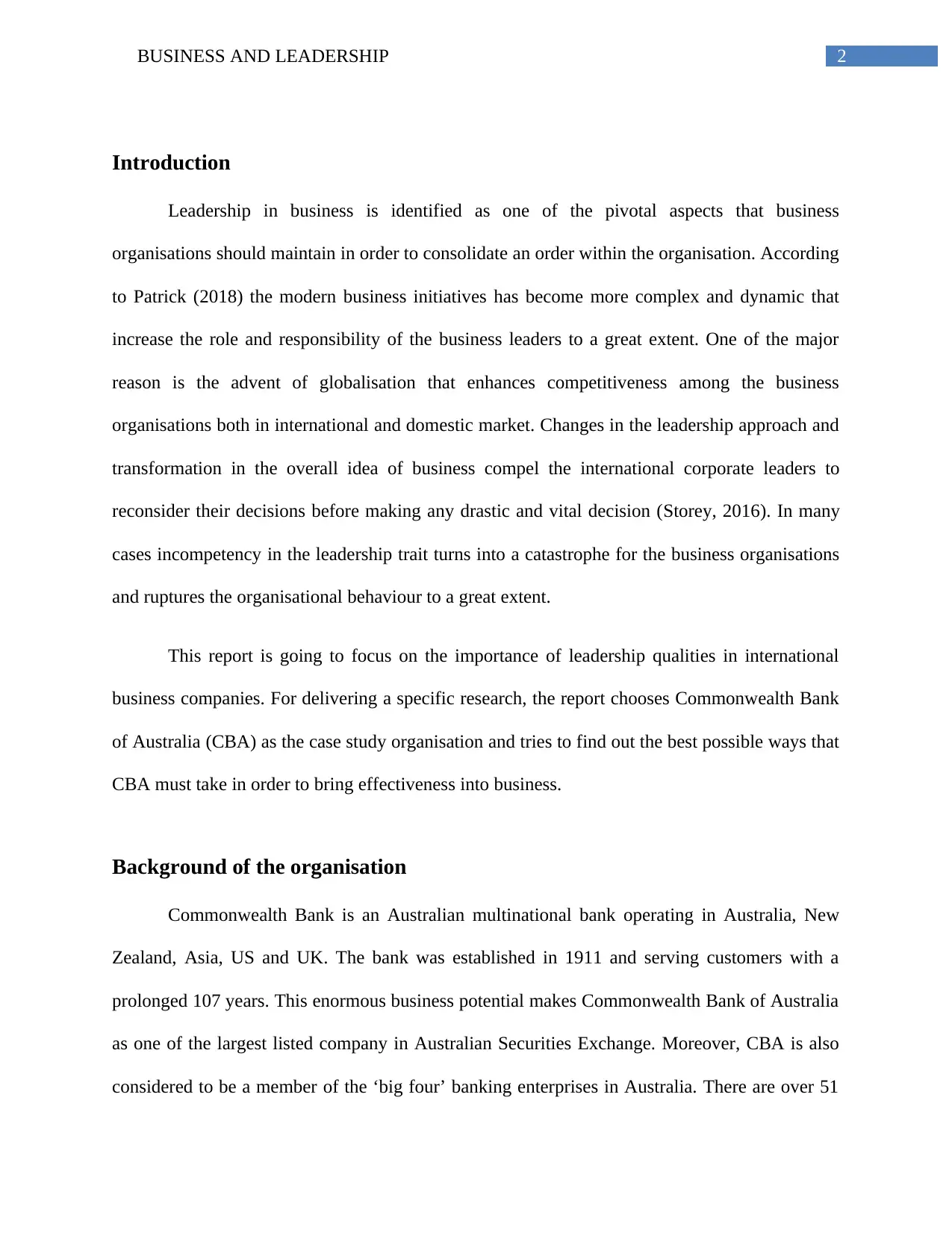
2BUSINESS AND LEADERSHIP
Introduction
Leadership in business is identified as one of the pivotal aspects that business
organisations should maintain in order to consolidate an order within the organisation. According
to Patrick (2018) the modern business initiatives has become more complex and dynamic that
increase the role and responsibility of the business leaders to a great extent. One of the major
reason is the advent of globalisation that enhances competitiveness among the business
organisations both in international and domestic market. Changes in the leadership approach and
transformation in the overall idea of business compel the international corporate leaders to
reconsider their decisions before making any drastic and vital decision (Storey, 2016). In many
cases incompetency in the leadership trait turns into a catastrophe for the business organisations
and ruptures the organisational behaviour to a great extent.
This report is going to focus on the importance of leadership qualities in international
business companies. For delivering a specific research, the report chooses Commonwealth Bank
of Australia (CBA) as the case study organisation and tries to find out the best possible ways that
CBA must take in order to bring effectiveness into business.
Background of the organisation
Commonwealth Bank is an Australian multinational bank operating in Australia, New
Zealand, Asia, US and UK. The bank was established in 1911 and serving customers with a
prolonged 107 years. This enormous business potential makes Commonwealth Bank of Australia
as one of the largest listed company in Australian Securities Exchange. Moreover, CBA is also
considered to be a member of the ‘big four’ banking enterprises in Australia. There are over 51
Introduction
Leadership in business is identified as one of the pivotal aspects that business
organisations should maintain in order to consolidate an order within the organisation. According
to Patrick (2018) the modern business initiatives has become more complex and dynamic that
increase the role and responsibility of the business leaders to a great extent. One of the major
reason is the advent of globalisation that enhances competitiveness among the business
organisations both in international and domestic market. Changes in the leadership approach and
transformation in the overall idea of business compel the international corporate leaders to
reconsider their decisions before making any drastic and vital decision (Storey, 2016). In many
cases incompetency in the leadership trait turns into a catastrophe for the business organisations
and ruptures the organisational behaviour to a great extent.
This report is going to focus on the importance of leadership qualities in international
business companies. For delivering a specific research, the report chooses Commonwealth Bank
of Australia (CBA) as the case study organisation and tries to find out the best possible ways that
CBA must take in order to bring effectiveness into business.
Background of the organisation
Commonwealth Bank is an Australian multinational bank operating in Australia, New
Zealand, Asia, US and UK. The bank was established in 1911 and serving customers with a
prolonged 107 years. This enormous business potential makes Commonwealth Bank of Australia
as one of the largest listed company in Australian Securities Exchange. Moreover, CBA is also
considered to be a member of the ‘big four’ banking enterprises in Australia. There are over 51
⊘ This is a preview!⊘
Do you want full access?
Subscribe today to unlock all pages.

Trusted by 1+ million students worldwide

3BUSINESS AND LEADERSHIP
thousands employees working in the bank and assisting in generating a revenue of AU$26 billion
in 2017 (Commbank.com.au, 2019). This huge revenue collection makes CBA as one of the
leading and promising banking company in Australia.
Analysis of the organisational behaviour
There are some significant issues that CBA is facing in course of dealing with the
organisational behaviour. There are three significant threats that Commonwealth Bank of
Australia is witnessing in course of business courses. All these misbehaviour in the
organisational context are severely responsible for the lack of leadership quality that the
organisation is practiced in course of time (Maddock, 2018). It becomes evident for
Commonwealth Bank of Australia to get a number of issues that are beyond the control of the
leaders. As a result of that the banking corporates was under the scrutiny of Royal Banking
Commission of Australia for a number of times. The issues are as follows,
Partial management practice
Based on the research and articles presented by the newspapers and media, it became
clear that there was strong partial organisational culture that CBA management endorsed
deliberately. As per the news article of Duran (2018) the partial management practice was
bestowed in the leadership practice of thethen CEO of Commonwealth Bank of Australia, Ian
Narev. As a charismatic leader, Ian Narev was always looking for people who corroborated his
vision of progress. As a result of that the potential candidates or employees were failed to come
to the forefront and did really good for the bank. This kind of partial management practice is
never expected from companies like Commonwealth Bank of Australia. As a matter of fact, the
thousands employees working in the bank and assisting in generating a revenue of AU$26 billion
in 2017 (Commbank.com.au, 2019). This huge revenue collection makes CBA as one of the
leading and promising banking company in Australia.
Analysis of the organisational behaviour
There are some significant issues that CBA is facing in course of dealing with the
organisational behaviour. There are three significant threats that Commonwealth Bank of
Australia is witnessing in course of business courses. All these misbehaviour in the
organisational context are severely responsible for the lack of leadership quality that the
organisation is practiced in course of time (Maddock, 2018). It becomes evident for
Commonwealth Bank of Australia to get a number of issues that are beyond the control of the
leaders. As a result of that the banking corporates was under the scrutiny of Royal Banking
Commission of Australia for a number of times. The issues are as follows,
Partial management practice
Based on the research and articles presented by the newspapers and media, it became
clear that there was strong partial organisational culture that CBA management endorsed
deliberately. As per the news article of Duran (2018) the partial management practice was
bestowed in the leadership practice of thethen CEO of Commonwealth Bank of Australia, Ian
Narev. As a charismatic leader, Ian Narev was always looking for people who corroborated his
vision of progress. As a result of that the potential candidates or employees were failed to come
to the forefront and did really good for the bank. This kind of partial management practice is
never expected from companies like Commonwealth Bank of Australia. As a matter of fact, the
Paraphrase This Document
Need a fresh take? Get an instant paraphrase of this document with our AI Paraphraser
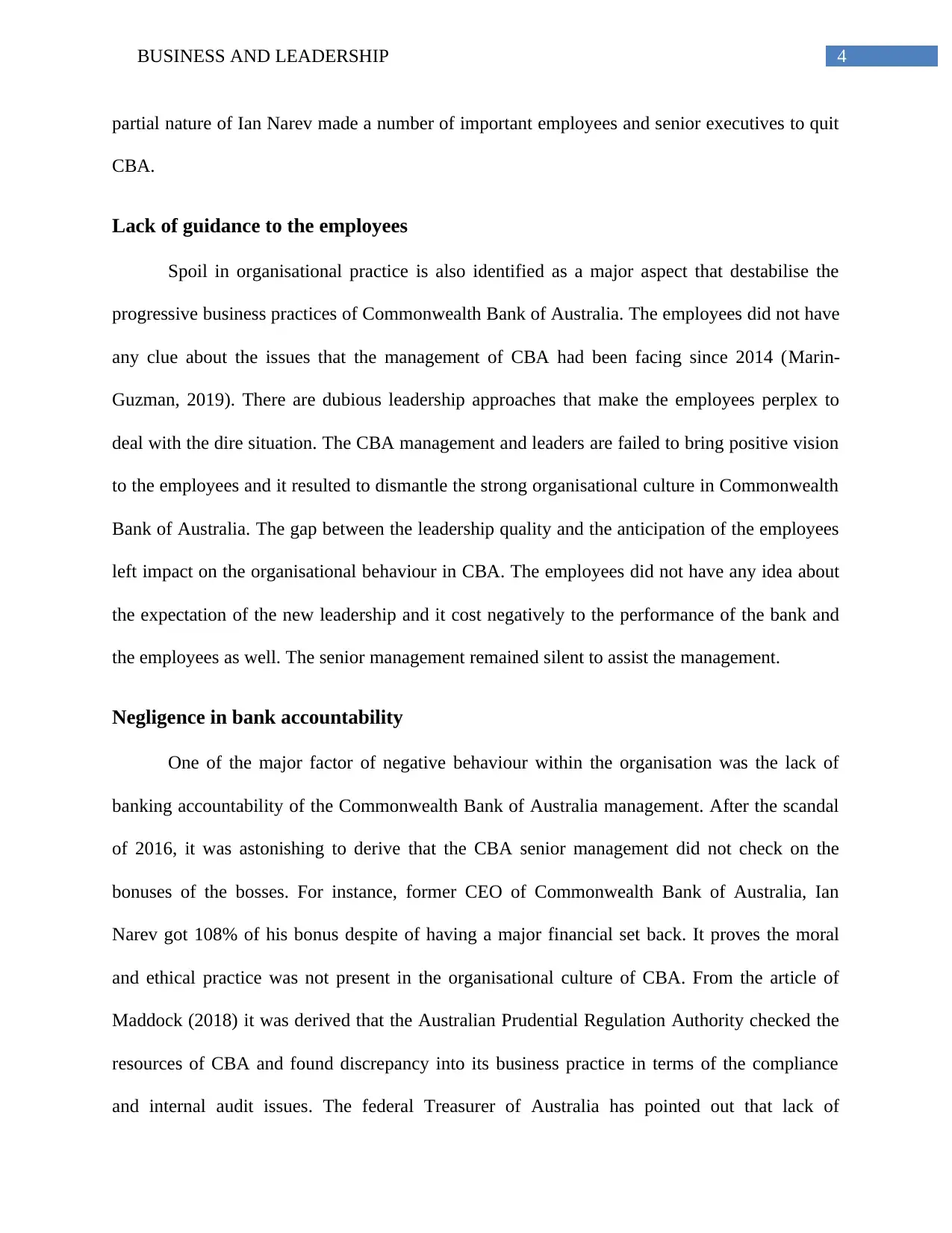
4BUSINESS AND LEADERSHIP
partial nature of Ian Narev made a number of important employees and senior executives to quit
CBA.
Lack of guidance to the employees
Spoil in organisational practice is also identified as a major aspect that destabilise the
progressive business practices of Commonwealth Bank of Australia. The employees did not have
any clue about the issues that the management of CBA had been facing since 2014 (Marin-
Guzman, 2019). There are dubious leadership approaches that make the employees perplex to
deal with the dire situation. The CBA management and leaders are failed to bring positive vision
to the employees and it resulted to dismantle the strong organisational culture in Commonwealth
Bank of Australia. The gap between the leadership quality and the anticipation of the employees
left impact on the organisational behaviour in CBA. The employees did not have any idea about
the expectation of the new leadership and it cost negatively to the performance of the bank and
the employees as well. The senior management remained silent to assist the management.
Negligence in bank accountability
One of the major factor of negative behaviour within the organisation was the lack of
banking accountability of the Commonwealth Bank of Australia management. After the scandal
of 2016, it was astonishing to derive that the CBA senior management did not check on the
bonuses of the bosses. For instance, former CEO of Commonwealth Bank of Australia, Ian
Narev got 108% of his bonus despite of having a major financial set back. It proves the moral
and ethical practice was not present in the organisational culture of CBA. From the article of
Maddock (2018) it was derived that the Australian Prudential Regulation Authority checked the
resources of CBA and found discrepancy into its business practice in terms of the compliance
and internal audit issues. The federal Treasurer of Australia has pointed out that lack of
partial nature of Ian Narev made a number of important employees and senior executives to quit
CBA.
Lack of guidance to the employees
Spoil in organisational practice is also identified as a major aspect that destabilise the
progressive business practices of Commonwealth Bank of Australia. The employees did not have
any clue about the issues that the management of CBA had been facing since 2014 (Marin-
Guzman, 2019). There are dubious leadership approaches that make the employees perplex to
deal with the dire situation. The CBA management and leaders are failed to bring positive vision
to the employees and it resulted to dismantle the strong organisational culture in Commonwealth
Bank of Australia. The gap between the leadership quality and the anticipation of the employees
left impact on the organisational behaviour in CBA. The employees did not have any idea about
the expectation of the new leadership and it cost negatively to the performance of the bank and
the employees as well. The senior management remained silent to assist the management.
Negligence in bank accountability
One of the major factor of negative behaviour within the organisation was the lack of
banking accountability of the Commonwealth Bank of Australia management. After the scandal
of 2016, it was astonishing to derive that the CBA senior management did not check on the
bonuses of the bosses. For instance, former CEO of Commonwealth Bank of Australia, Ian
Narev got 108% of his bonus despite of having a major financial set back. It proves the moral
and ethical practice was not present in the organisational culture of CBA. From the article of
Maddock (2018) it was derived that the Australian Prudential Regulation Authority checked the
resources of CBA and found discrepancy into its business practice in terms of the compliance
and internal audit issues. The federal Treasurer of Australia has pointed out that lack of

5BUSINESS AND LEADERSHIP
negligence from the senior management’s end made it clear that malpractice in the organisational
behaviour became evident in case of Commonwealth Bank of Australia.
Theoretical application
Leadership skills and practices are considered to be important aspects for the business
organisations in order to ensure high proficiency in the business practice. In this regard, this
section is going to discuss a leadership practice that will help to shape the organisational culture
in Commonwealth Bank of Australia. Therefore, the leadership practices are associated with
Transformational leadership practice.
Transformational leadership
Hoch et al. (2018) defined transformational leadership from the point of view of a moral
practice that the business leaders should follow in order to bring a positive and creative
inspiration to the employees. As a matter of fact, from the research of Banks et al. (2016) it can
be corroborated that the transformational leadership practice can bring good corporate culture
and more independence in the workplace. On the other hand, Dong et al. (2017) articulated that
transformational leadership is such a measure that can build trust over the employees and highly
aspiring the employees to incur more creativity and innovativeness in their performance. As a
result of that it subsequently helps to build up a strong organisational performance based on
morality and ethical standpoint. There are certainly a number of aspects that the transformational
leadership possesses such as
Inspirational motivation
The foundation of transformational leadership is based on focusing the vision, mission
and set of values for the leaders so that their values can contribute to the positive impact on the
negligence from the senior management’s end made it clear that malpractice in the organisational
behaviour became evident in case of Commonwealth Bank of Australia.
Theoretical application
Leadership skills and practices are considered to be important aspects for the business
organisations in order to ensure high proficiency in the business practice. In this regard, this
section is going to discuss a leadership practice that will help to shape the organisational culture
in Commonwealth Bank of Australia. Therefore, the leadership practices are associated with
Transformational leadership practice.
Transformational leadership
Hoch et al. (2018) defined transformational leadership from the point of view of a moral
practice that the business leaders should follow in order to bring a positive and creative
inspiration to the employees. As a matter of fact, from the research of Banks et al. (2016) it can
be corroborated that the transformational leadership practice can bring good corporate culture
and more independence in the workplace. On the other hand, Dong et al. (2017) articulated that
transformational leadership is such a measure that can build trust over the employees and highly
aspiring the employees to incur more creativity and innovativeness in their performance. As a
result of that it subsequently helps to build up a strong organisational performance based on
morality and ethical standpoint. There are certainly a number of aspects that the transformational
leadership possesses such as
Inspirational motivation
The foundation of transformational leadership is based on focusing the vision, mission
and set of values for the leaders so that their values can contribute to the positive impact on the
⊘ This is a preview!⊘
Do you want full access?
Subscribe today to unlock all pages.

Trusted by 1+ million students worldwide
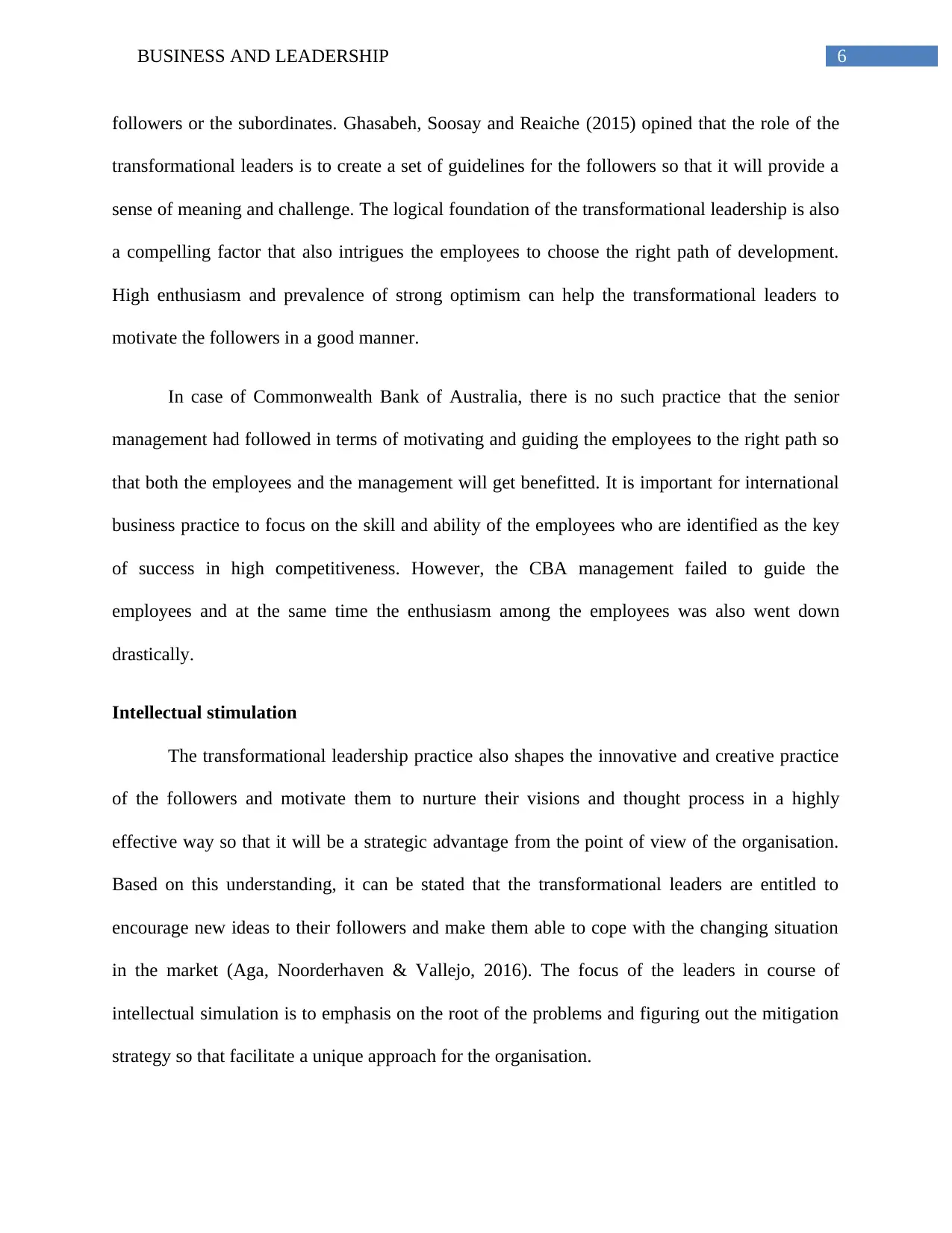
6BUSINESS AND LEADERSHIP
followers or the subordinates. Ghasabeh, Soosay and Reaiche (2015) opined that the role of the
transformational leaders is to create a set of guidelines for the followers so that it will provide a
sense of meaning and challenge. The logical foundation of the transformational leadership is also
a compelling factor that also intrigues the employees to choose the right path of development.
High enthusiasm and prevalence of strong optimism can help the transformational leaders to
motivate the followers in a good manner.
In case of Commonwealth Bank of Australia, there is no such practice that the senior
management had followed in terms of motivating and guiding the employees to the right path so
that both the employees and the management will get benefitted. It is important for international
business practice to focus on the skill and ability of the employees who are identified as the key
of success in high competitiveness. However, the CBA management failed to guide the
employees and at the same time the enthusiasm among the employees was also went down
drastically.
Intellectual stimulation
The transformational leadership practice also shapes the innovative and creative practice
of the followers and motivate them to nurture their visions and thought process in a highly
effective way so that it will be a strategic advantage from the point of view of the organisation.
Based on this understanding, it can be stated that the transformational leaders are entitled to
encourage new ideas to their followers and make them able to cope with the changing situation
in the market (Aga, Noorderhaven & Vallejo, 2016). The focus of the leaders in course of
intellectual simulation is to emphasis on the root of the problems and figuring out the mitigation
strategy so that facilitate a unique approach for the organisation.
followers or the subordinates. Ghasabeh, Soosay and Reaiche (2015) opined that the role of the
transformational leaders is to create a set of guidelines for the followers so that it will provide a
sense of meaning and challenge. The logical foundation of the transformational leadership is also
a compelling factor that also intrigues the employees to choose the right path of development.
High enthusiasm and prevalence of strong optimism can help the transformational leaders to
motivate the followers in a good manner.
In case of Commonwealth Bank of Australia, there is no such practice that the senior
management had followed in terms of motivating and guiding the employees to the right path so
that both the employees and the management will get benefitted. It is important for international
business practice to focus on the skill and ability of the employees who are identified as the key
of success in high competitiveness. However, the CBA management failed to guide the
employees and at the same time the enthusiasm among the employees was also went down
drastically.
Intellectual stimulation
The transformational leadership practice also shapes the innovative and creative practice
of the followers and motivate them to nurture their visions and thought process in a highly
effective way so that it will be a strategic advantage from the point of view of the organisation.
Based on this understanding, it can be stated that the transformational leaders are entitled to
encourage new ideas to their followers and make them able to cope with the changing situation
in the market (Aga, Noorderhaven & Vallejo, 2016). The focus of the leaders in course of
intellectual simulation is to emphasis on the root of the problems and figuring out the mitigation
strategy so that facilitate a unique approach for the organisation.
Paraphrase This Document
Need a fresh take? Get an instant paraphrase of this document with our AI Paraphraser
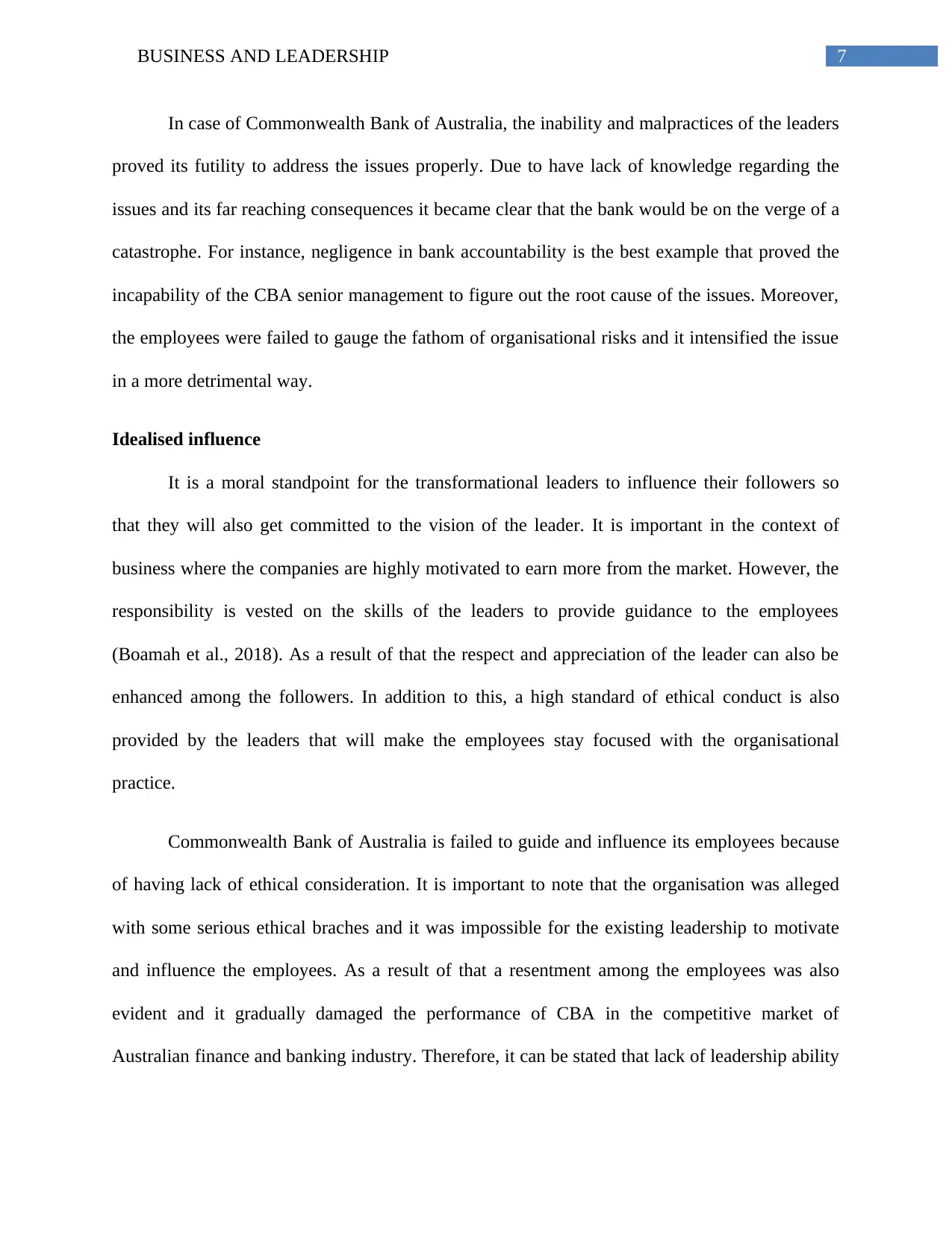
7BUSINESS AND LEADERSHIP
In case of Commonwealth Bank of Australia, the inability and malpractices of the leaders
proved its futility to address the issues properly. Due to have lack of knowledge regarding the
issues and its far reaching consequences it became clear that the bank would be on the verge of a
catastrophe. For instance, negligence in bank accountability is the best example that proved the
incapability of the CBA senior management to figure out the root cause of the issues. Moreover,
the employees were failed to gauge the fathom of organisational risks and it intensified the issue
in a more detrimental way.
Idealised influence
It is a moral standpoint for the transformational leaders to influence their followers so
that they will also get committed to the vision of the leader. It is important in the context of
business where the companies are highly motivated to earn more from the market. However, the
responsibility is vested on the skills of the leaders to provide guidance to the employees
(Boamah et al., 2018). As a result of that the respect and appreciation of the leader can also be
enhanced among the followers. In addition to this, a high standard of ethical conduct is also
provided by the leaders that will make the employees stay focused with the organisational
practice.
Commonwealth Bank of Australia is failed to guide and influence its employees because
of having lack of ethical consideration. It is important to note that the organisation was alleged
with some serious ethical braches and it was impossible for the existing leadership to motivate
and influence the employees. As a result of that a resentment among the employees was also
evident and it gradually damaged the performance of CBA in the competitive market of
Australian finance and banking industry. Therefore, it can be stated that lack of leadership ability
In case of Commonwealth Bank of Australia, the inability and malpractices of the leaders
proved its futility to address the issues properly. Due to have lack of knowledge regarding the
issues and its far reaching consequences it became clear that the bank would be on the verge of a
catastrophe. For instance, negligence in bank accountability is the best example that proved the
incapability of the CBA senior management to figure out the root cause of the issues. Moreover,
the employees were failed to gauge the fathom of organisational risks and it intensified the issue
in a more detrimental way.
Idealised influence
It is a moral standpoint for the transformational leaders to influence their followers so
that they will also get committed to the vision of the leader. It is important in the context of
business where the companies are highly motivated to earn more from the market. However, the
responsibility is vested on the skills of the leaders to provide guidance to the employees
(Boamah et al., 2018). As a result of that the respect and appreciation of the leader can also be
enhanced among the followers. In addition to this, a high standard of ethical conduct is also
provided by the leaders that will make the employees stay focused with the organisational
practice.
Commonwealth Bank of Australia is failed to guide and influence its employees because
of having lack of ethical consideration. It is important to note that the organisation was alleged
with some serious ethical braches and it was impossible for the existing leadership to motivate
and influence the employees. As a result of that a resentment among the employees was also
evident and it gradually damaged the performance of CBA in the competitive market of
Australian finance and banking industry. Therefore, it can be stated that lack of leadership ability
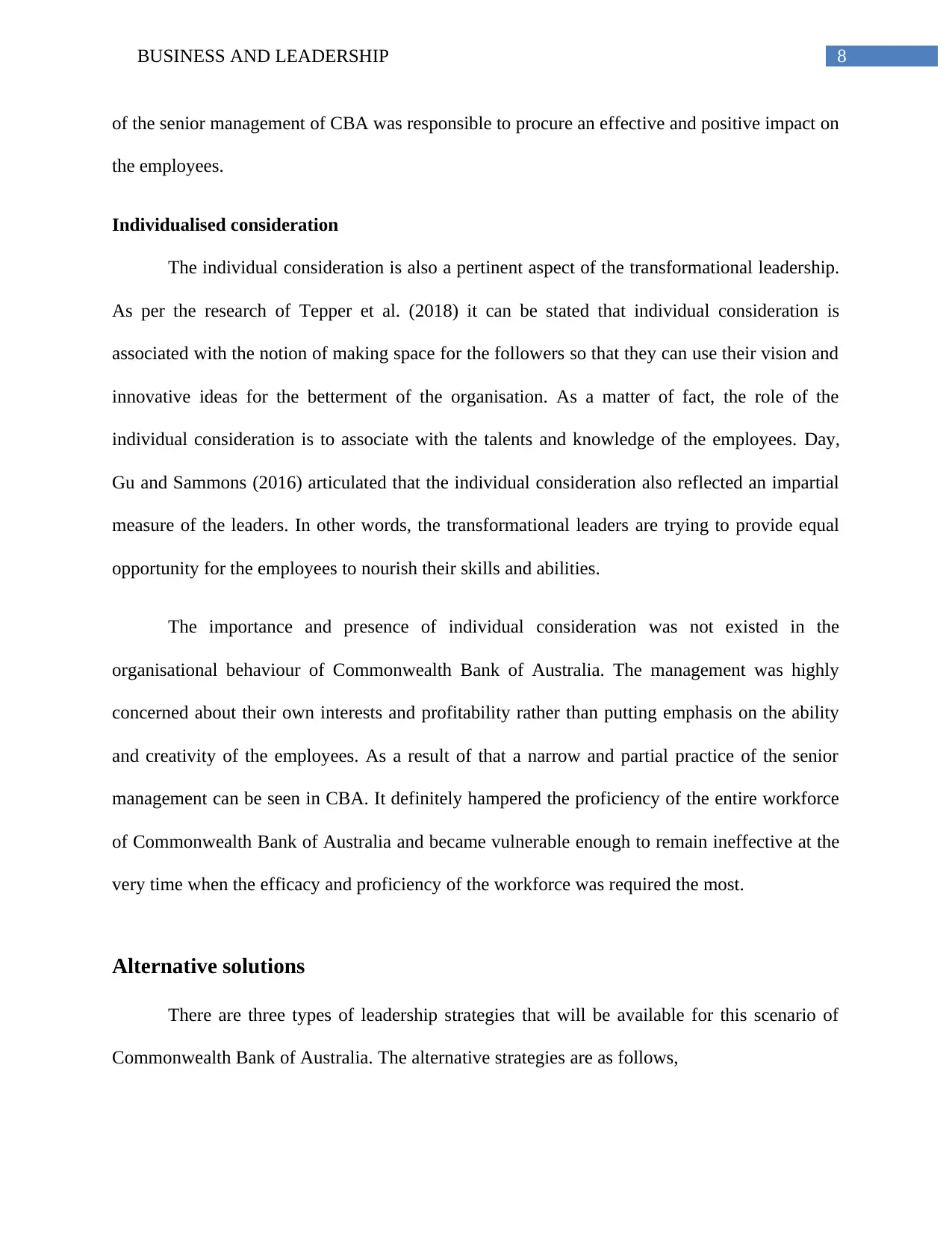
8BUSINESS AND LEADERSHIP
of the senior management of CBA was responsible to procure an effective and positive impact on
the employees.
Individualised consideration
The individual consideration is also a pertinent aspect of the transformational leadership.
As per the research of Tepper et al. (2018) it can be stated that individual consideration is
associated with the notion of making space for the followers so that they can use their vision and
innovative ideas for the betterment of the organisation. As a matter of fact, the role of the
individual consideration is to associate with the talents and knowledge of the employees. Day,
Gu and Sammons (2016) articulated that the individual consideration also reflected an impartial
measure of the leaders. In other words, the transformational leaders are trying to provide equal
opportunity for the employees to nourish their skills and abilities.
The importance and presence of individual consideration was not existed in the
organisational behaviour of Commonwealth Bank of Australia. The management was highly
concerned about their own interests and profitability rather than putting emphasis on the ability
and creativity of the employees. As a result of that a narrow and partial practice of the senior
management can be seen in CBA. It definitely hampered the proficiency of the entire workforce
of Commonwealth Bank of Australia and became vulnerable enough to remain ineffective at the
very time when the efficacy and proficiency of the workforce was required the most.
Alternative solutions
There are three types of leadership strategies that will be available for this scenario of
Commonwealth Bank of Australia. The alternative strategies are as follows,
of the senior management of CBA was responsible to procure an effective and positive impact on
the employees.
Individualised consideration
The individual consideration is also a pertinent aspect of the transformational leadership.
As per the research of Tepper et al. (2018) it can be stated that individual consideration is
associated with the notion of making space for the followers so that they can use their vision and
innovative ideas for the betterment of the organisation. As a matter of fact, the role of the
individual consideration is to associate with the talents and knowledge of the employees. Day,
Gu and Sammons (2016) articulated that the individual consideration also reflected an impartial
measure of the leaders. In other words, the transformational leaders are trying to provide equal
opportunity for the employees to nourish their skills and abilities.
The importance and presence of individual consideration was not existed in the
organisational behaviour of Commonwealth Bank of Australia. The management was highly
concerned about their own interests and profitability rather than putting emphasis on the ability
and creativity of the employees. As a result of that a narrow and partial practice of the senior
management can be seen in CBA. It definitely hampered the proficiency of the entire workforce
of Commonwealth Bank of Australia and became vulnerable enough to remain ineffective at the
very time when the efficacy and proficiency of the workforce was required the most.
Alternative solutions
There are three types of leadership strategies that will be available for this scenario of
Commonwealth Bank of Australia. The alternative strategies are as follows,
⊘ This is a preview!⊘
Do you want full access?
Subscribe today to unlock all pages.

Trusted by 1+ million students worldwide

9BUSINESS AND LEADERSHIP
Leading from the front
Leading from the front is identified as one of the unique strategies that current leaders are
used in order to influence and incorporate the employees to a great extent. In this regard, there is
a sharp distinction between the managers and the leaders. From the research of Bell, Dyck and
Neubert (2017) it can be stated that managers are entitled to manage people but do not set an
example for the employees so that they will guide towards the ultimate goal. On the other hand,
the leading from the front practice definitely has a positive impact on the employees and the
managers are able to set example for the employees by incorporating and engaging them into the
working process. In addition to this, Khan (2017) pointed out that leading from the front practice
has a correlation with the broader strategic objectives so that it will formulate an effective and
positive mind-set between the employees and the managers. Furthermore, Ju et al. (2015) argued
that leading from the front does not require to move the manager or the leader at first but it
defined clear objectives, intention and the full awareness about the consequences of the process.
As a result of that a good relation between the manager and the employees can be set and it will
provide a good performance for the organisation.
Supportive leadership style
Supportive leadership is identified as a unique feature of leadership style that the business
organisations and managers are often used in the process of enhancing employee loyalty, well-
being and most importantly work performance in the organisation. In course of defining
supportive leadership style Renko et al. (2015) articulated that supportive leadership style was
primarily focused on the delegation and interested in working through the tasks with employees.
As a result of that the employees can easily ventilate their problems and issues to the leaders
because the team lead or the managers is always available for the employees and entitled to
Leading from the front
Leading from the front is identified as one of the unique strategies that current leaders are
used in order to influence and incorporate the employees to a great extent. In this regard, there is
a sharp distinction between the managers and the leaders. From the research of Bell, Dyck and
Neubert (2017) it can be stated that managers are entitled to manage people but do not set an
example for the employees so that they will guide towards the ultimate goal. On the other hand,
the leading from the front practice definitely has a positive impact on the employees and the
managers are able to set example for the employees by incorporating and engaging them into the
working process. In addition to this, Khan (2017) pointed out that leading from the front practice
has a correlation with the broader strategic objectives so that it will formulate an effective and
positive mind-set between the employees and the managers. Furthermore, Ju et al. (2015) argued
that leading from the front does not require to move the manager or the leader at first but it
defined clear objectives, intention and the full awareness about the consequences of the process.
As a result of that a good relation between the manager and the employees can be set and it will
provide a good performance for the organisation.
Supportive leadership style
Supportive leadership is identified as a unique feature of leadership style that the business
organisations and managers are often used in the process of enhancing employee loyalty, well-
being and most importantly work performance in the organisation. In course of defining
supportive leadership style Renko et al. (2015) articulated that supportive leadership style was
primarily focused on the delegation and interested in working through the tasks with employees.
As a result of that the employees can easily ventilate their problems and issues to the leaders
because the team lead or the managers is always available for the employees and entitled to
Paraphrase This Document
Need a fresh take? Get an instant paraphrase of this document with our AI Paraphraser
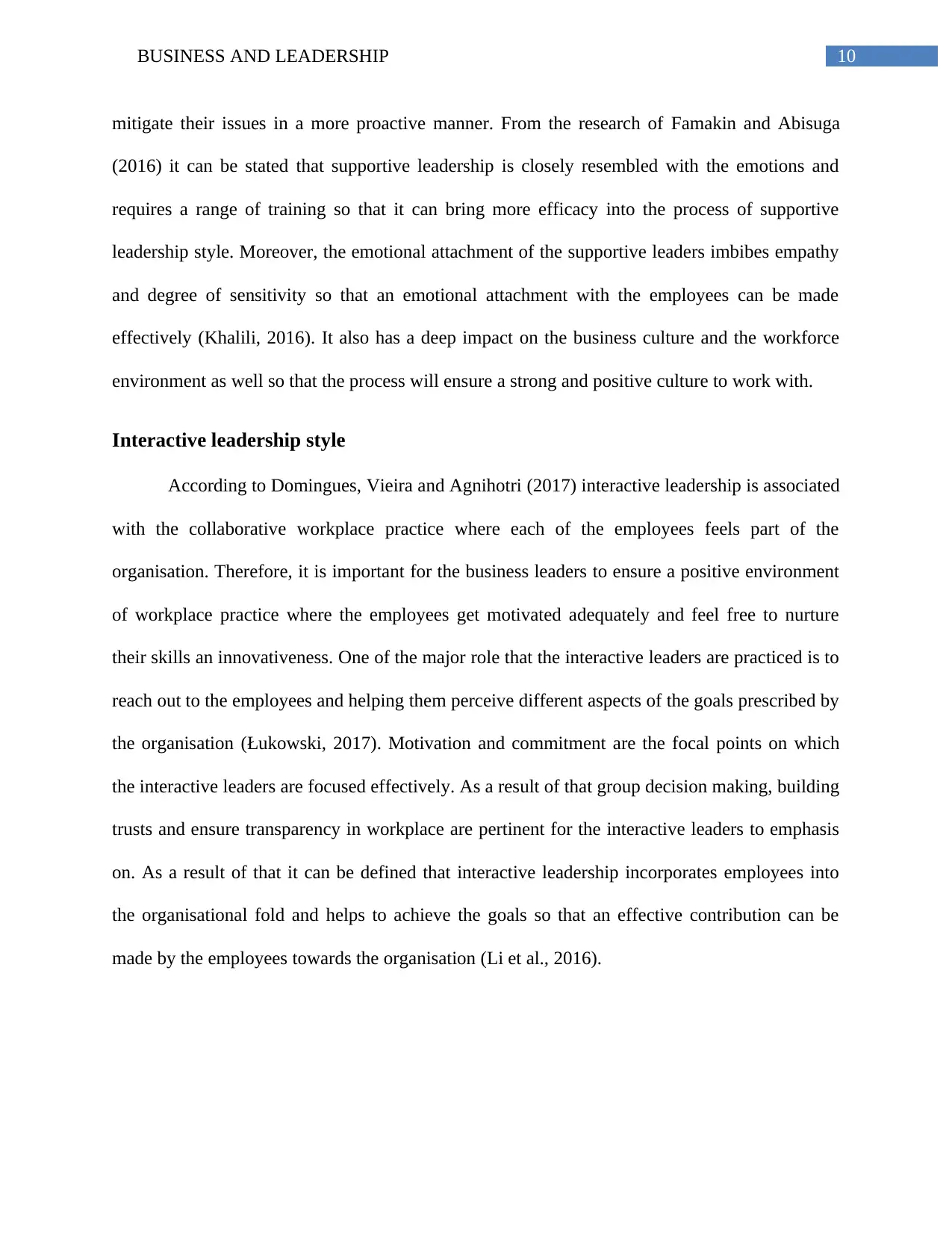
10BUSINESS AND LEADERSHIP
mitigate their issues in a more proactive manner. From the research of Famakin and Abisuga
(2016) it can be stated that supportive leadership is closely resembled with the emotions and
requires a range of training so that it can bring more efficacy into the process of supportive
leadership style. Moreover, the emotional attachment of the supportive leaders imbibes empathy
and degree of sensitivity so that an emotional attachment with the employees can be made
effectively (Khalili, 2016). It also has a deep impact on the business culture and the workforce
environment as well so that the process will ensure a strong and positive culture to work with.
Interactive leadership style
According to Domingues, Vieira and Agnihotri (2017) interactive leadership is associated
with the collaborative workplace practice where each of the employees feels part of the
organisation. Therefore, it is important for the business leaders to ensure a positive environment
of workplace practice where the employees get motivated adequately and feel free to nurture
their skills an innovativeness. One of the major role that the interactive leaders are practiced is to
reach out to the employees and helping them perceive different aspects of the goals prescribed by
the organisation (Łukowski, 2017). Motivation and commitment are the focal points on which
the interactive leaders are focused effectively. As a result of that group decision making, building
trusts and ensure transparency in workplace are pertinent for the interactive leaders to emphasis
on. As a result of that it can be defined that interactive leadership incorporates employees into
the organisational fold and helps to achieve the goals so that an effective contribution can be
made by the employees towards the organisation (Li et al., 2016).
mitigate their issues in a more proactive manner. From the research of Famakin and Abisuga
(2016) it can be stated that supportive leadership is closely resembled with the emotions and
requires a range of training so that it can bring more efficacy into the process of supportive
leadership style. Moreover, the emotional attachment of the supportive leaders imbibes empathy
and degree of sensitivity so that an emotional attachment with the employees can be made
effectively (Khalili, 2016). It also has a deep impact on the business culture and the workforce
environment as well so that the process will ensure a strong and positive culture to work with.
Interactive leadership style
According to Domingues, Vieira and Agnihotri (2017) interactive leadership is associated
with the collaborative workplace practice where each of the employees feels part of the
organisation. Therefore, it is important for the business leaders to ensure a positive environment
of workplace practice where the employees get motivated adequately and feel free to nurture
their skills an innovativeness. One of the major role that the interactive leaders are practiced is to
reach out to the employees and helping them perceive different aspects of the goals prescribed by
the organisation (Łukowski, 2017). Motivation and commitment are the focal points on which
the interactive leaders are focused effectively. As a result of that group decision making, building
trusts and ensure transparency in workplace are pertinent for the interactive leaders to emphasis
on. As a result of that it can be defined that interactive leadership incorporates employees into
the organisational fold and helps to achieve the goals so that an effective contribution can be
made by the employees towards the organisation (Li et al., 2016).
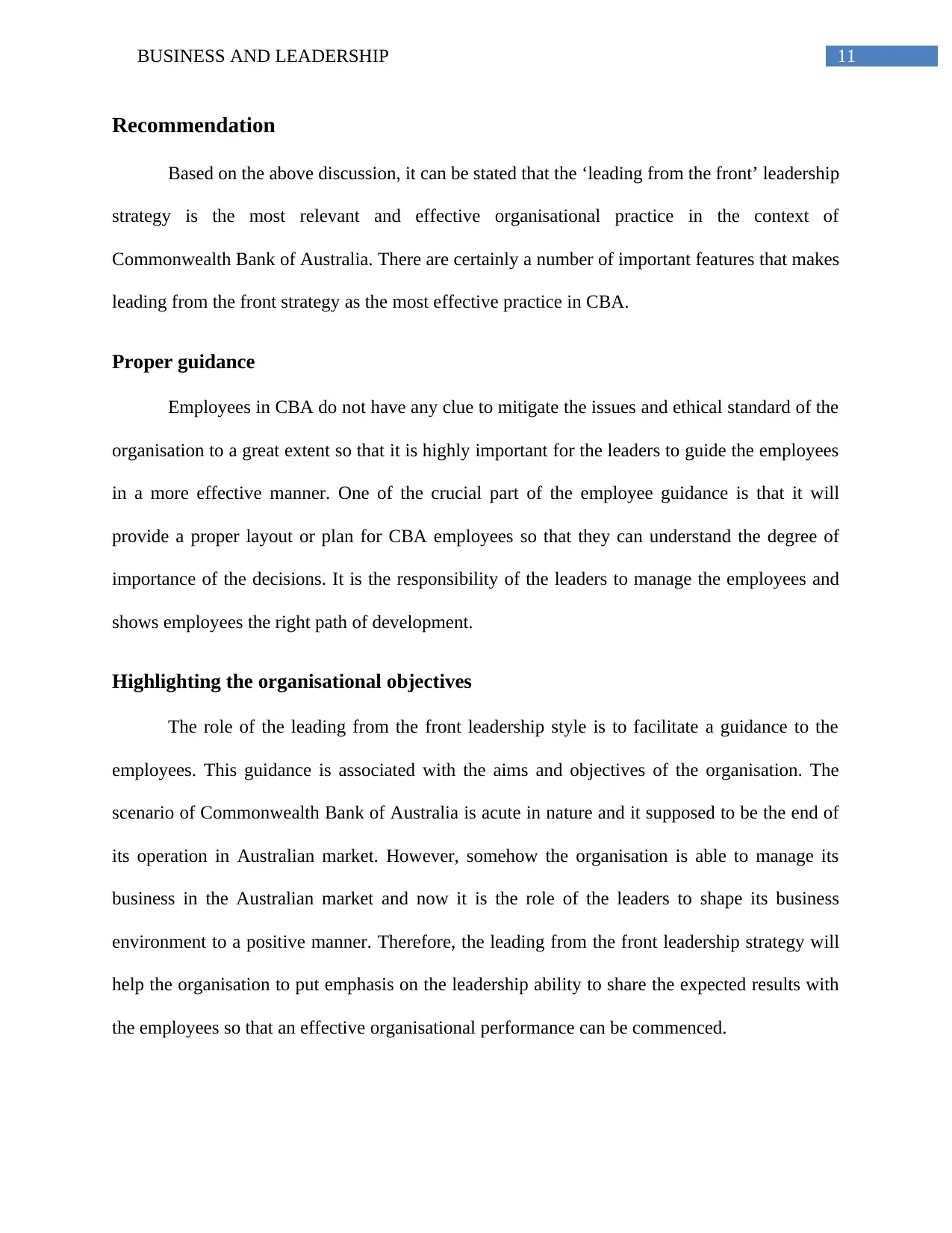
11BUSINESS AND LEADERSHIP
Recommendation
Based on the above discussion, it can be stated that the ‘leading from the front’ leadership
strategy is the most relevant and effective organisational practice in the context of
Commonwealth Bank of Australia. There are certainly a number of important features that makes
leading from the front strategy as the most effective practice in CBA.
Proper guidance
Employees in CBA do not have any clue to mitigate the issues and ethical standard of the
organisation to a great extent so that it is highly important for the leaders to guide the employees
in a more effective manner. One of the crucial part of the employee guidance is that it will
provide a proper layout or plan for CBA employees so that they can understand the degree of
importance of the decisions. It is the responsibility of the leaders to manage the employees and
shows employees the right path of development.
Highlighting the organisational objectives
The role of the leading from the front leadership style is to facilitate a guidance to the
employees. This guidance is associated with the aims and objectives of the organisation. The
scenario of Commonwealth Bank of Australia is acute in nature and it supposed to be the end of
its operation in Australian market. However, somehow the organisation is able to manage its
business in the Australian market and now it is the role of the leaders to shape its business
environment to a positive manner. Therefore, the leading from the front leadership strategy will
help the organisation to put emphasis on the leadership ability to share the expected results with
the employees so that an effective organisational performance can be commenced.
Recommendation
Based on the above discussion, it can be stated that the ‘leading from the front’ leadership
strategy is the most relevant and effective organisational practice in the context of
Commonwealth Bank of Australia. There are certainly a number of important features that makes
leading from the front strategy as the most effective practice in CBA.
Proper guidance
Employees in CBA do not have any clue to mitigate the issues and ethical standard of the
organisation to a great extent so that it is highly important for the leaders to guide the employees
in a more effective manner. One of the crucial part of the employee guidance is that it will
provide a proper layout or plan for CBA employees so that they can understand the degree of
importance of the decisions. It is the responsibility of the leaders to manage the employees and
shows employees the right path of development.
Highlighting the organisational objectives
The role of the leading from the front leadership style is to facilitate a guidance to the
employees. This guidance is associated with the aims and objectives of the organisation. The
scenario of Commonwealth Bank of Australia is acute in nature and it supposed to be the end of
its operation in Australian market. However, somehow the organisation is able to manage its
business in the Australian market and now it is the role of the leaders to shape its business
environment to a positive manner. Therefore, the leading from the front leadership strategy will
help the organisation to put emphasis on the leadership ability to share the expected results with
the employees so that an effective organisational performance can be commenced.
⊘ This is a preview!⊘
Do you want full access?
Subscribe today to unlock all pages.

Trusted by 1+ million students worldwide
1 out of 17
Related Documents
Your All-in-One AI-Powered Toolkit for Academic Success.
+13062052269
info@desklib.com
Available 24*7 on WhatsApp / Email
![[object Object]](/_next/static/media/star-bottom.7253800d.svg)
Unlock your academic potential
Copyright © 2020–2025 A2Z Services. All Rights Reserved. Developed and managed by ZUCOL.




